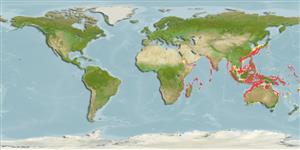Teleostei (teleosts) >
Perciformes/Scorpaenoidei (Scorpionfishes) >
Peristediidae (Armored searobins or armored gurnards)
Etymology: Satyrichthys: Latin, satyrus = a god or demon, partly human and partly bestial, companion of Bacchus + Greek, ichthys = fish (Ref. 45335); laticeps: Probably named after Haley..
Environment: milieu / climate zone / depth range / distribution range
Ecology
Marine; demersal; depth range 58 - 300 m (Ref. 93228). Subtropical
Indo-West Pacific: Arabian Sea, Saya de Malha Bank, off Indian coast of southern Africa (including Sri lanka and the Andaman Sea); south to Japan, Taiwan, East China Sea, to Sulu Sea, South China Sea, and Indonesia.
Size / Weight / Age
Maturity: Lm ? range ? - ? cm
Max length : 48.7 cm SL male/unsexed; (Ref. 93228)
Short description
Identification keys | Morphology | Morphometrics
Dorsal soft rays (total): 13 - 17; Anal soft rays: 14 - 17. This species is distinguished by the following characters: barbels 4 (rarely 3 or 5) lip and 2-5 on the chin; presence of antrose spines on upper lateral bony plates of caudal peduncle; parietal bones unequal in size on midline; dusky spots on dorsal fin absent (Ref. 93228).
Life cycle and mating behavior
Maturities | Reproduction | Spawnings | Egg(s) | Fecundities | Larvae
Kawai, T., 2013. Revision of the peristediid genus Satyrichthys (Actinopterygii: Teleostei) with the description of a new species, S. milleri sp. nov. Zootaxa 3635(4):419-438. (Ref. 93228)
IUCN Red List Status (Ref. 130435)
Threat to humans
Harmless
Human uses
Tools
Special reports
Download XML
Internet sources
Estimates based on models
Preferred temperature (Ref.
123201): 14.2 - 26.6, mean 20.2 °C (based on 464 cells).
Phylogenetic diversity index (Ref.
82804): PD
50 = 0.5078 [Uniqueness, from 0.5 = low to 2.0 = high].
Bayesian length-weight: a=0.00589 (0.00368 - 0.00942), b=3.06 (2.92 - 3.20), in cm total length, based on LWR estimates for this species & (Sub)family-body (Ref.
93245).
Trophic level (Ref.
69278): 3.6 ±0.3 se; based on size and trophs of closest relatives
Resilience (Ref.
120179): Low, minimum population doubling time 4.5 - 14 years (Preliminary K or Fecundity.).
Fishing Vulnerability (Ref.
59153): Moderate vulnerability (44 of 100).
